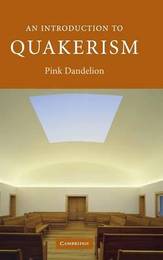
|
An Introduction to Quakerism
Hardback
Main Details
| Title |
An Introduction to Quakerism
|
| Authors and Contributors |
By (author) Pink Dandelion
|
| Series | Introduction to Religion |
|---|
| Physical Properties |
| Format:Hardback | | Pages:294 | | Dimensions(mm): Height 229,Width 157 |
|
| ISBN/Barcode |
9780521841115
|
| Classifications | Dewey:289.6 |
|---|
| Audience | | Professional & Vocational | | General | | Tertiary Education (US: College) | |
|---|
| Illustrations |
20 Halftones, unspecified
|
|
Publishing Details |
| Publisher |
Cambridge University Press
|
| Imprint |
Cambridge University Press
|
| Publication Date |
12 April 2007 |
| Publication Country |
United Kingdom
|
Description
This is a comprehensive introduction to Quakerism which balances a history of the theology of the Quakers or Friends with an overview of present day practice. It charts the growth of the Quaker movement through the 1650s and 1660s, its different theological emphasis in the eighteenth century, and the schisms of the nineteenth century which resulted in the range of Quaker traditions found around the world today. The book focuses in particular on notions of 'endtime', 'spiritual intimacy', and what counts as 'the world' as key areas of theological change. The second half of the book uses extracts from Quaker texts to highlight differences in belief and approach between the different traditions and analyses their future prospects. The book is generously illustrated and includes numerous diagrams to help the reader. Undergraduate and graduate students will find this an essential introduction to the Quaker movement.
Author Biography
Pink Dandelion is Programme Leader, Centre for Postgraduate Quaker Studies at Woodbrooke Quaker Studies Centre and Honorary Reader in Quaker Studies at the University of Birmingham.
Reviews'With the prospect that Quakerism, given its current numerical decline, could disappear from Britain by around 2032, the need to tell the story of this remarkable religious tradition is self-evident. In An Introduction to Quakerism, Pink Dandelion combines a historical record with a subtle promotion of the tradition's idiosyncrasies, which may yet contribute to its renewal here.' Church Times
|